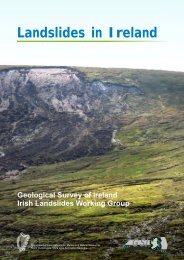PDF Download (2.6Mb) - Geological Survey of Ireland
PDF Download (2.6Mb) - Geological Survey of Ireland
PDF Download (2.6Mb) - Geological Survey of Ireland
You also want an ePaper? Increase the reach of your titles
YUMPU automatically turns print PDFs into web optimized ePapers that Google loves.
eing served from 40 countries. Hosted by<br />
each <strong>Geological</strong> <strong>Survey</strong>, each participant<br />
delivers its map or maps through a<br />
standard web service (WMS/WFS). The<br />
list <strong>of</strong> metadata, or data about the data,<br />
is collected into a catalogue service and<br />
managed “centrally”. With this in place<br />
the portal can then display/aggregate all<br />
the maps. The central portal is located in<br />
France and is run by the French <strong>Geological</strong><br />
<strong>Survey</strong>, BRGM. There were 420,000 visits<br />
to the portal at www.onegeology.org in the<br />
first six months, 50,000 on the opening<br />
day. Recently, the portal stayed up even<br />
when hit 29 million times in one month, a<br />
testament to the resilience and strength <strong>of</strong><br />
the service provided. A Technical Working<br />
group defines standards for OneGeology,<br />
and provides technical specification for the<br />
services and the portal. They also provide<br />
“Cookbooks” which explain to participating<br />
<strong>Geological</strong> <strong>Survey</strong>s how to set up the<br />
services using open source s<strong>of</strong>tware, and<br />
they provide technical support. Another<br />
working group has developed a standard<br />
language to exchange geoscientific<br />
data, GeoSciML, which is based on<br />
GML (Geography Markup Language).<br />
To guarantee consistency, the project<br />
team also have links with standardization<br />
bodies.<br />
The Future<br />
Future aims include increasing the<br />
number <strong>of</strong> countries participating, and<br />
moving progressively from delivering<br />
data by WMS, which provides data as<br />
an image/raster, to WFS which provides<br />
data with Geometry (points, polygons,<br />
lines) and attributes (text). With the aim <strong>of</strong><br />
getting more sustainable governance and<br />
funding, it is hoped to move OneGeology<br />
to a not-for-pr<strong>of</strong>it incorporated status.<br />
EAGE Near Surface<br />
Geophysics Conference<br />
Dublin, September 2009<br />
Xavier Pellicer & Enda Gallagher<br />
Geology Matters: Winter 2009<br />
300 leading scientists from all over Europe converged on Dublin from 7-9<br />
September for a conference that celebrated cutting-edge Irish geological<br />
research. “Near surface geophysics” is an important component in <strong>Ireland</strong>’s<br />
recent infrastructural development. It involves the extensive study <strong>of</strong> the<br />
earth that lies immediately underground. The conference, which was hosted<br />
in Trinity College Dublin, highlighted various Irish projects and methodologies<br />
spread across a range <strong>of</strong> sectors including engineering, environment and<br />
archaeology, together with examples <strong>of</strong> their application to Irish projects.<br />
This is an area <strong>of</strong> geoscience with considerable potential for developing a<br />
specialist knowledge-based internationally-traded service industry. That<br />
was according to the minister who opened the conference, Conor Lenihan,<br />
Minister <strong>of</strong> State at the Department <strong>of</strong> Communications, Energy and Natural<br />
Resources. “The important role that engineering geophysics has played over<br />
the last 15 years in ground investigation for major infrastructural projects<br />
in <strong>Ireland</strong>’s National Development Plan has encouraged the conference<br />
organisers – the European Association <strong>of</strong> Geoscientists and Engineers - to<br />
select <strong>Ireland</strong> to host the conference for the very first time”, he said.<br />
In explaining the importance <strong>of</strong> near surface geophysics to <strong>Ireland</strong>, conference<br />
organiser, Peter O’Connor, referred to the unprecedented nature <strong>of</strong> <strong>Ireland</strong>’s<br />
infrastructural and industrial development over the last decade. Much <strong>of</strong><br />
this has required large scale ground investigation studies, he said. “These<br />
studies now make use <strong>of</strong> near surface geophysics techniques to help us<br />
gain a more detailed understanding <strong>of</strong> the underlying environment <strong>of</strong> the site,<br />
for example, how sound it is for its planned purpose.” Appropriate use <strong>of</strong><br />
geophysical methods assists in assessing if the siting <strong>of</strong> a development in a<br />
particular location is appropriate, reduces overall project costs and minimises<br />
risk, he said.<br />
Mapping the Earth’s rocks<br />
Electrical Resistivity Tomography (ERT) pr<strong>of</strong>ile. This technique generates pr<strong>of</strong>iles <strong>of</strong><br />
the sub-surface, showing variations on the resistivity <strong>of</strong> materials to electrical current.<br />
Lithological variations occurring within 25m <strong>of</strong> the subsurface can be inferred. Main<br />
variations are related to grain size and sorting. Moreover depth to bedrock can be<br />
estimated with high accuracy.<br />
page 15

















